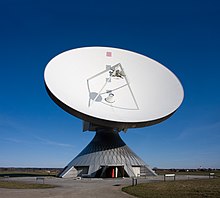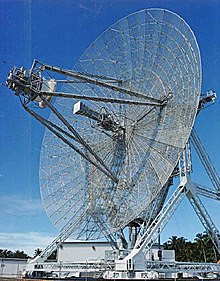Parabolic antenna
A parabolic antenna , also known colloquially as an antenna dish or satellite dish , bundles electromagnetic radiation at the focal point of a metal parabolic mirror . There the radiation is recorded by a detector, usually a horn antenna , and passed on.


Areas of application
For communication with satellites close to the earth , reflectors with diameters of 10 m and more are used. Large parabolic antennas with diameters of up to 100 meters can be found in the ground stations for monitoring and controlling interplanetary spacecraft, in radio telescopes and in radar devices for extraterrestrial use. ESTRACK is the name of ESA's "Deep Space" network that performs these tasks.
The antenna of the Arecibo Observatory with a diameter of 304.8 m is not a parabolic antenna, but spherical.
Parabolic antennas are also used for directional radio .
Technical specifications
The gain G of a parabolic antenna increases with the antenna area A and decreases with the wavelength λ , is a dimensionless parameter and stands for the aperture efficiency. In the case of parabolic mirrors, the geometric area (A) generally corresponds to the effective area (Aw) of the antenna. If the parabola is deformed or the exciter moves away from the focal point, the effective area can be smaller than the geometric area (aperture) of the parabolic reflector. The efficiency or the aperture efficiency then becomes smaller. Typical values for parabolic antennas are between 0.8 and 0.99:
- (1)
For example, an antenna with a diameter of 70 cm for a frequency of 10 GHz has a gain of about 35 dBi.
With increasing profit, the bundling of radiation increases, the opening angle α decreases. The angle approximately follows from the ratio of wavelength λ and aperture diameter D , if one limits the drop in intensity of the beam to ± 3 dB:
- (2) degree
or, as a rough approximation:
- (2a)
The 70 cm parabolic antenna from the example above consequently has a beam focusing of around 4 °. Satellites that are closer together can no longer be registered independently of one another.
A horn radiator achieves an efficiency of more than 80%. But its maximum gain is limited to 25 dB. The efficiency of a parabolic antenna is 50–70%. It should therefore only be used when high gain and small opening angles are required. But it only brings good profits if its diameter is large compared to the transmitted wavelength. The lower limit is around eight times the wavelength.
For example, geostationary satellites with horn radiators without reflectors transmit when they want to illuminate as large a part of the earth's surface as possible. From the satellite, the earth appears at an angle of around 17 °. A parabolic antenna could only achieve this large opening according to (2) with a diameter of 4λ, but with a much poorer efficiency and 'unpleasant' radiation pattern.
Designs
As the wavelength decreases, microwaves approach the properties of light. The roughness or the structural dimensions of the surfaces that reflect the radiation must be below about a quarter of the wavelength, in the case of microwaves in the millimeter to centimeter range. Metal grids are often sufficient to reflect the radiation. This reduces the wind load and the mass.
A distinction is made between different designs of parabolic antennas :
Parabolic antenna
The normal form of the parabolic antenna consists of a rotationally symmetrical structure ( paraboloid ), the sectional view of which is a parabola . The exciter (receiving or transmitting part) is located in the focal point of the paraboloid on the axis of rotation (no offset) or outside the axis of rotation (offset). The design without offset is used particularly for large antennas.
Central or primary focus antenna
It is also called PFA (= "prime focus antenna") in English, because the transmitting and / or receiving part is located in the main focus of the paraboloid. An important parameter of such antennas is the ratio of focus to diameter ("f / D ratio").
Offset antenna
Offset antennas are used because the form without offset has the problem that the primary radiator lies between the reflector and the incident wave. It and the arm to which it is attached therefore cast a shadow on the reflector. This area of the reflector is therefore ineffective. This phenomenon can also be traced optically under solar radiation, since the shading in light is similar to that of the received waves. The annoying shadowing increases as the antenna surfaces become smaller. This problem is solved in that only a small, laterally lying partial section of the paraboloid of revolution is realized, so that the exciter (focal point) comes to lie next to the incoming wave front. This also changes the angle of incidence. Due to the changed angle of incidence, the parabolic mirror is inclined in relation to the incoming wave front, which means that in our latitudes, the mirror can be set up almost vertically. This has the further advantage that no snow can deposit on the mirror, which would otherwise dampen the waves.
Cassegrain antenna
With Cassegrain antennas [ kasgʀɛn ] there is a subreflector at the point of the exciter. This is hyperbolically convex and has two focal points . One focal point coincides with the focal point of the parabolic mirror and lies behind the subreflector, the second focal point is at the point where the pathogen is located, usually in a hole in the center of the parabolic surface. The Cassegrain principle and the Gregory principle described below can also be found in reflector telescopes , see Cassegrain telescope and Gregory telescope .
Gregory antenna
Gregory antennas have a sub-reflector , similar to Cassegrain antennas. This sub-reflector is ellipsoidally concave and has two focal points . One focal point of this ellipsoid coincides with the focal point of the paraboloid and lies between the two reflectors, the second focal point is at the point where the pathogen is located, usually in a hole in the center of the parabolic surface.
Torus antenna
In the case of the torus antenna , the parabola that forms the reflector is not rotated around the axis of the main beam direction, but around an axis that is perpendicular to it. An arc-shaped reflector is created. It allows connections with several geostationary satellites.
Bundling
The larger a parabolic antenna, the more energy is collected in the focal point and the more precisely it has to be aimed at the remote station, for example a satellite .
Surface treatment
The surface of the parabolic mirror can be treated to protect against corrosion or to adapt to the environment. For this purpose, the manufacturers use lacquers or powder coatings. Adhesive foils and synthetic resin lacquers are unsuitable because they introduce additional attenuation in the reception path. Furthermore, the paint should be matt, because otherwise the solar radiation will be reflected on the horn when it is behind the target object (sun outage). Otherwise, the bundled rays of the sun can overheat and destroy the horn.
Web links
- Calculation of the Cassegrain sub-reflector (English; PDF; 158 kB)
- Calculations on the Cassegrain antenna
Individual evidence
- ↑ Archived copy ( memento of the original dated February 4, 2015 in the Internet Archive ) Info: The archive link was inserted automatically and has not yet been checked. Please check the original and archive link according to the instructions and then remove this notice.
- ↑ Prime Focus Satellite Antenna reflector calculation. Retrieved April 17, 2017 .






